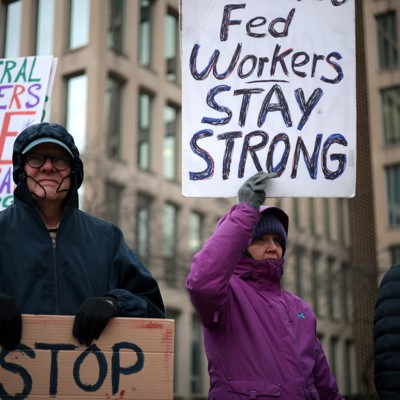President Trump began his second term in office by signing an executive order to create the Department of Government Efficiency and institute a sweeping federal hiring freeze, exempting only positions related to immigration enforcement and security.
Eight days later, the new administration sent an email to all existing employees showcasing their underlying philosophy about the government workforce: “The way to greater American prosperity is encouraging people to move from lower productivity jobs in the public sector to higher productivity jobs in the private sector.” Their plan failed–a very small percentage of workers took the bait. But the misguided philosophy behind these efforts showcases a fundamental misunderstanding of what it takes to keep America running. The reality is this: if we want the federal government to efficiently and effectively deliver for Americans, we need to invest in strengthening it, not break it.
The idea that cutting staff will improve the federal government isn’t new. It was popular in the 1980s and ’90s and it failed – often leading to contractors doing the same work with less accountability at a greater cost. What we’ve learned is that whether the civil service is “too big” or “too small” depends on what we want it to do. And right now, huge parts of government are facing not bloat but vacancies: a shortage of air traffic controllers to keep pace with commercial flights, firefighters leaving the U.S. Forest Service, and a dearth of housing specialists who we depend on to stabilize the housing market. These shortages don’t just cause inefficiencies – they put Americans at risk. A shrinking public workforce means more contaminated food and water, dangerous roads and bridges, longer processing times for business permits, passports, and Social Security checks. An aging workforce is only exacerbating the problem.
Encouraging more employees to self-select out will leave Americans with fewer protections, longer delays, and a government ill-equipped to meet their needs.
To fix this human capital crisis, the evidence is clear: we need to build a pipeline of talent that makes government jobs more accessible, attracts specialized talent and ensures public service is a sustainable career. This also means supporting the employees that are already committed to public service: reducing the conditions that lead to burnout, strengthening career mobility opportunities across departments, and giving public servants the tools and resources to do their jobs effectively. The current DOGE playbook is calling public servants “the opposing team” or “a ball of worms” while blocking the influx of skilled professionals who want to serve their country. This hostile approach is driving away the very employees we need the most.
The irony is that the people who the administration is denigrating en masse were already implementing the types of efficiency gains that DOGE aspires to, both under Republican and Democratic administrations. We’ve seen success stories where agencies work to reorient services around the customer and reduce administrative hurdles has made a real difference not just to how services are delivered, but also to who receives those services. If DOGE’s goal were truly to improve the productivity of the private sector, they would be scaling up–not dismantling–the teams who have saved 21 million hours of Americans’ time by simplifying forms. Or they would celebrate the U.S. Customs and Border Protection (CBP) teams that transitioned ocean shipping data to digital formats, drastically reducing cargo clearance time and enabling trade that underpins our economy.
If we care about more than just efficiency, we also need to tell the stories of the public servants who were already expanding access to life-saving medication; the innovators who are supporting young parents with their newborns; the VA teams that are rebuilding veteran trust; and the countless others who make the system work and keep us safe.
This work is often invisible, but it’s essential. From disaster response to social safety nets to child protection, we ask our public sector workforce to take on the responsibilities that no one else can shoulder. These needs won’t disappear just because we decide to cut the agencies that handle them. Americans of all political stripes agree – we want a government that works. The real challenge isn’t gutting the workforce; it’s investing in the people, processes, and policies that allow the government to function. The future of democracy depends on it.
Octavia Abell is CEO of Govern America, which works to encourage young people to join the public sector. Elizabeth Linos is the Emma Bloomberg Associate Professor for Public Policy and Management, and Faculty Director of The People Lab at the Harvard Kennedy School of Government.




